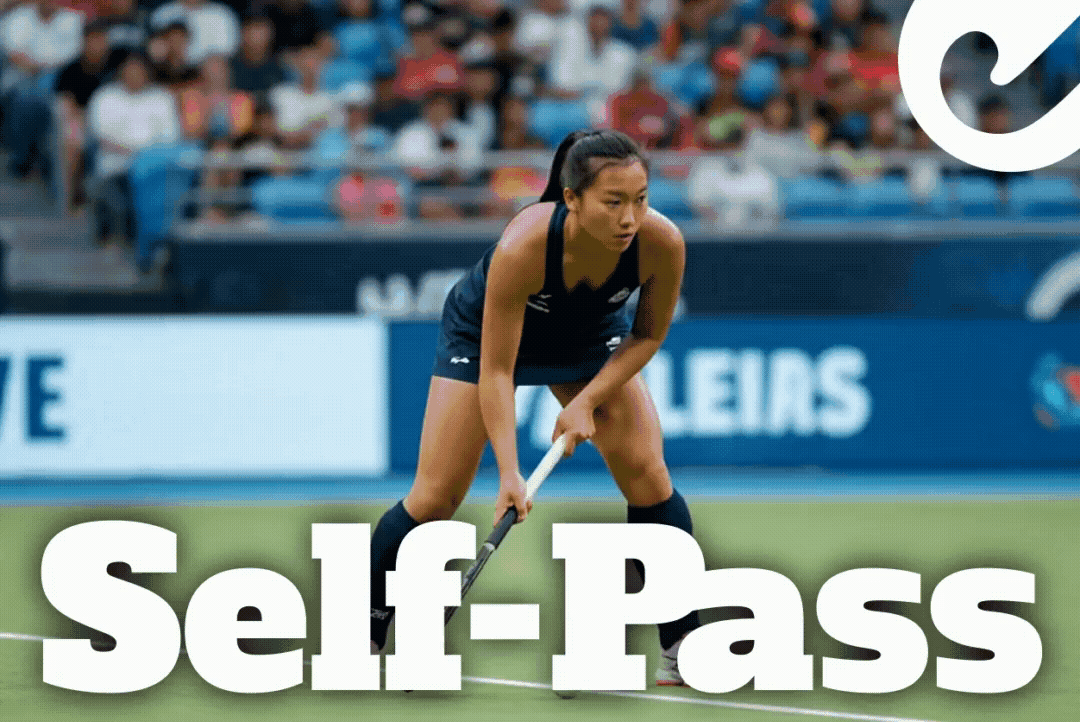The self-pass
About the principles in coaching and training the self-pass in field hockey
The self-pass is one of the most versatile tools in modern field hockey. Introduced as part of the free-hit rule changes by the Euro Hockey League, it has transformed the way the game is played. Offering players the ability to restart play quickly and exploit gaps in the opposition’s structure. But like any tool, its effectiveness depends on how and when it’s used. Decision-making around the self-pass is as critical as the technical execution itself. As Raoul Ehren once said during an AMA session:
“The best players aren’t just technically skilled, they know when to use the right tool at the right time” .
We’ll explore the principles of the self-pass, how to train decision-making around it for youth and performance teams, and how to integrate it into your team’s tactical framework.
The Principles of the Self-Pass
At its core, the self-pass is about creating opportunities. It allows the player taking the free hit to maintain possession while immediately putting the opposition under pressure. Here are the key principles:
1. Speed and Surprise
The self-pass is most effective when it’s taken quickly, catching the opposition off guard. This requires players to be alert and ready to act as soon as the whistle blows. Alyson Annan, in her masterclass on circle behavior, emphasized the importance of intent:
Every action on the field should have a purpose. The self-pass is no different. It’s about creating time and space for yourself or your teammates
2. Exploiting Space
The self-pass is particularly useful when there’s open space ahead. By taking the ball themselves, players can drive into that space, forcing defenders to react and potentially creating numerical advantages.
3. Drawing Defenders
A well-executed self-pass can draw defenders out of position, opening up passing lanes or creating opportunities for teammates to make runs. It’s not always about advancing the ball, sometimes, often, it’s about manipulating the opposition’s structure.
4. Awareness and Scanning
Before taking a self-pass, players need to scan the field to assess their options. Are there teammates in better positions? Is there space to exploit? As Robert Noall pointed out in his workshop on decision-making,
“If you can’t see your options, you can’t make the right decision” .
5. Tactical Context
The decision to use a self-pass should align with the team’s tactical objectives. For example, in a high-press situation, a quick self-pass might be used to bypass the first line of defense and transition into attack. Conversely, in a more controlled build-up, the self-pass might be used to draw defenders and create space elsewhere.
Training Decision-Making for the Self-Pass
Decision-making around the self-pass is a skill that can be developed through targeted training. Here’s how to approach it for different levels of players:
For Youth Teams
Youth players are still developing their understanding of the game, so the focus should be on building a strong foundation of technical skills and situational awareness.
Teach the Basics
Start by teaching the technical execution of the self-pass. Emphasize the importance of keeping the ball within playing distance and maintaining control.
Use simple drills to practice the mechanics, such as taking a self-pass and dribbling into open space.
Introduce Game-Like Scenarios
Create small-sided games where players are encouraged to use the self-pass in specific situations. For example, set up a drill where players must take a self-pass to enter the attacking 25.
Use constraints to guide decision-making. For instance, limit the number of passes allowed after a self-pass to encourage players to think about their next move.
Encourage Scanning
Teach players to scan the field before taking a self-pass. Use drills that require them to identify their options quickly, such as calling out the number of defenders or open spaces before executing the pass.
Celebrate Good Decisions
Highlight and praise instances where players use the self-pass effectively. This reinforces positive behavior and builds confidence.
For Performance Teams
With performance teams, the focus shifts to refining decision-making and integrating the self-pass into the team’s tactical framework.
Analyze and Reflect
Use video analysis to review how and when players are using the self-pass. Highlight both good and bad decisions, and discuss alternative options.
Encourage players to reflect on their decision-making process. Ask questions like, “What did you see before taking the self-pass?” or “What other options did you consider?”
Simulate High-Pressure Scenarios
Design drills that replicate game situations, such as taking a self-pass under pressure from defenders. This helps players develop the ability to make quick decisions in challenging conditions.
Use full-field games with specific objectives, such as transitioning from defense to attack using the self-pass.
Focus on Tactical Context
Work on integrating the self-pass into your team’s tactical strategies. For example, practice using the self-pass to bypass a high press or create overloads in the midfield.
Discuss the risks and rewards of using the self-pass in different areas of the field. For instance, a self-pass in the defensive third might be riskier but could be effective in breaking a press.
Encourage Creativity
Give players the freedom to experiment with the self-pass in training. Encourage them to try different approaches and learn from their mistakes.
Adapting for Mixed-Ability Teams
In teams with varying skill levels, it’s important to tailor your approach to meet the needs of each player.
Pair Players Strategically
Pair less experienced players with more advanced ones during drills. This allows the stronger players to model good habits and helps the less experienced players learn through observation.
Use Layered Objectives
Design drills with multiple objectives that cater to different skill levels. For example, in a self-pass drill, less experienced players might focus on executing the pass correctly, while advanced players work on scanning and decision-making.
Foster a Supportive Environment
Encourage collaboration and communication between players. Emphasize that everyone has a role to play, regardless of their skill level.
Celebrate team successes and highlight how players supported each other in using the self-pass effectively.
Common Mistakes and How to Address Them
Rushing the Self-Pass
Players often rush the self-pass without scanning the field or considering their options. Address this by emphasizing the importance of awareness and decision-making in training.
Overusing the Self-Pass
Some players rely too heavily on the self-pass, even when other options might be more effective. Use video analysis to highlight these instances and discuss alternative approaches.
Poor Execution
Technical errors, such as losing control of the ball, can undermine the effectiveness of the self-pass. Focus during technical drills on building consistency and confidence
Final Thoughts
The self-pass is a powerful tool, but its effectiveness depends on how and when it’s used. By focusing on the principles of speed, space, awareness, and tactical context, coaches can help players develop the skills and decision-making abilities needed to use the self-pass effectively. Whether you’re working with youth players or performance teams, the key is to create training environments that replicate game situations and encourage players to think critically about their decisions.
So, how are you currently coaching the self-pass with your team? Are there specific challenges you’re facing, or strategies that have worked well for you? If you’d like to dive deeper into this topic or discuss tailored approaches for your team, feel free to reach out.
By the way, did you know the EHL, inventor of the self-pass, starts today?
The Euro Hockey League or EHL is always a special event. Clubs from all over Europe that performed well the season before in their own domestic leagues qualify. For many hockey players and coaches who do not make their national team, this is the highest level of hockey. This excitement to be a part of an EHL playing team is real. It might not always attract full stadiums of fans, but those who are there are real close to their team and the emotions run high.
Besides all of this the EHL has brought us innovations like the self pass and many other small or big improvements that made their way to the game all over the world. You get to see the best of the best play with the players they chose to play with… In short I love the EHL
16 teams from 11 different countries battle it out over the next four days with 16 knock-out matches for you to savour.
Watch every minute of the tournament LIVE on www.eurohockeytv.org! Get your event pass for €9.99. Unless you live in Belgium where you can watch it on DAZN and South America where ESPN will be your channel.
Enjoy or as they say in Barcelona: Disfruta!





